Southsea sea defences: Behind the scenes on the first stage of a £100m project
and live on Freeview channel 276
Even as far back as the Victorian era man-made defences were put in place along Southsea to compensate for this, with various projects adding to the fortifications over the years.
But there’s no doubt these barricades have taken a battering in recent times.
Advertisement
Hide AdAdvertisement
Hide AdSince 1900 the sea level around the UK has risen by about 16cm.
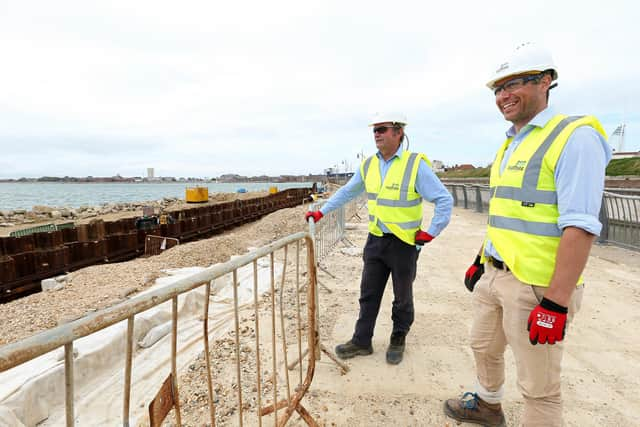

At the current rate of emissions, it is predicted the sea surrounding Portsmouth is likely to rise by at least double this amount in the next three decades, and potentially triple it by 2059.
So now work is underway to ensure the best protection for the city - with new defences being constructed from Old Portsmouth all the way along the coastline to Eastney.
This is part of a landmark £100m Portsmouth City Council-led project that is set to last 100 years.
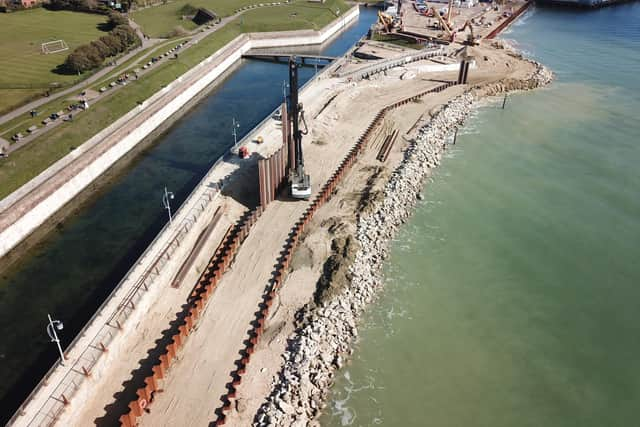

Advertisement
Hide AdAdvertisement
Hide AdPlans for the scheme were in the works for years and the first public consultation was held in 2014, followed by more in 2018 and 2019.
In 2019 planning permission was granted for the first phase of the works at Long Curtain Moat, for which construction started in September, and last year £97.8m was secured from the Environment Agency to proceed.
The whole scheme has been broken up into six sections: Long Curtain Moat, Southsea Castle, Southsea Common, Pyramids to the Pier, Canoe Lake and Clarence Pier - to be completed in this order.
Long Curtain Moat (or Frontage 1) is on schedule to be completed by August 2022.
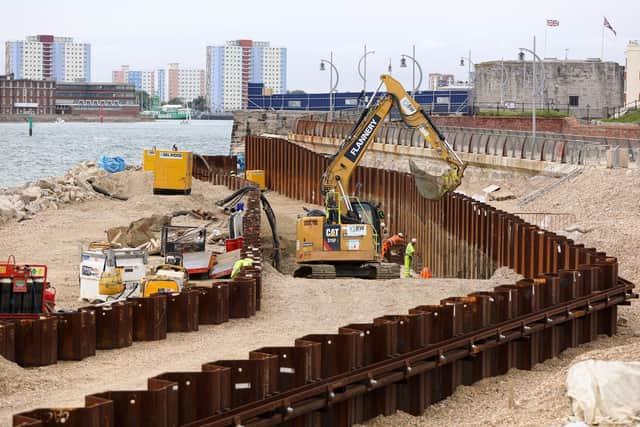

Advertisement
Hide AdAdvertisement
Hide AdIt is this section that The News has been granted access to - to learn more about what is required to protect the land.
Members of the public passing by this area of Southsea will be aware that something is going on, with access to Long Curtain Moat currently prohibited.
Since last year a section of the common has been used as temporary office space for workers of the Southsea Coastal Scheme, complete with a car park and fencing.
And around the corner, the Clarence Pier car park is occupied by equipment and workforce.
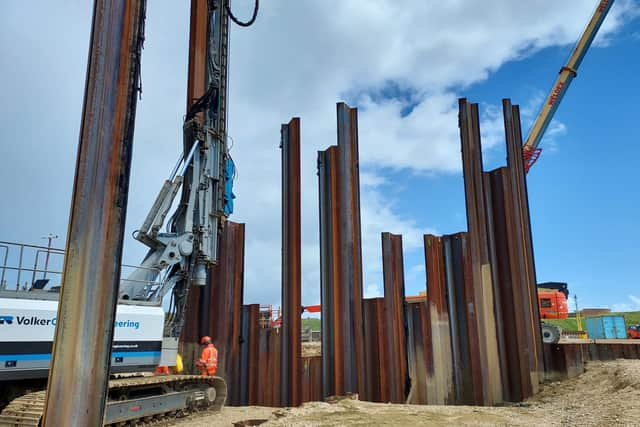

Advertisement
Hide AdAdvertisement
Hide AdBehind this, an area of Ministry of Defence land has also been repurposed as a processing site to recycle any materials retrieved from the area. Most recycled material will be used to raise the height of roads and promenades along the coastline as part of the scheme.
But since work began in September what has been done so far?
Frontage 1 has been divided into two areas - Frontage 1 east and Frontage 1 west. The east site covers from the western edge of Clarence Pier to the start of Spur Redoubt, and the west includes from Spur Redoubt to the start of the Hot Walls - which are not included in the project.
Along the eastern section sheet piles have been assembled along the waterfront. These are 17.5 metre long pieces of steel that knit together and sit about 15 metres under the water and are the foundation of the defences.
Advertisement
Hide AdAdvertisement
Hide AdAlready tonnes of armour rock has been distributed across the front of these sheet piles, which remains mostly underwater during a high tide. To encourage marine life to thrive here 18 tide pools have been implemented between the rocks.
Between the west and east section of Frontage 1, 11,000 tonnes of armour rock will be used.
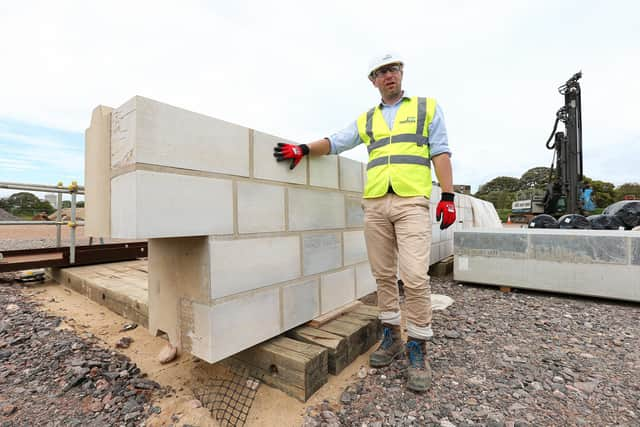

The next steps here involve raising the height of the promenade by 1.5 metres to match the height of the car park behind. The placement of the sheet piles will also allow the promenade to be made four metres wider, and a 1.1 metre pre-cast concrete wall will border the walkway without restricting the seaview.
Coastal defence manager at Portsmouth City Council, Guy Mason, said the new design here was ‘key.’
Advertisement
Hide AdAdvertisement
Hide Ad‘It’s great what we’re going to be able to achieve here,’ he said.
‘Through our designs we’re able to make the walkway larger because it was a bit narrow before, making it more accessible to people.’
To allow work to be possible a specialist Dutch dredging vessel, the Sospan Dau, was brought in to create a temporary working platform last year. It did this using material dredged from the seabed that was initially been dumped there after dredging to make way for the Queen Elizabeth-class aircraft carriers.
Southsea Coastal Scheme project manager Rupert Teasdale said: ‘You can see the dredged material here now. We are starting to lose some of it naturally to the waves but when it’s no longer needed it will be returned to the sea.’
Advertisement
Hide AdAdvertisement
Hide AdMoving along to the western section of Frontage 1 and it’s a slightly different picture.
Two rows of steel piles have already been installed, which will create a two-level effect once complete. Currently the first row of the piles has not been cut down to size yet as they are used as protection from the wind for workers in the trench below.
In front of the first row of sheet piles more armour rock - which is sitting ready to go on the east side - will be placed as added protection.
Guy said: ‘It’s going to offer a superb vista here. We are really pleased with the way this is going to look.’
Advertisement
Hide AdAdvertisement
Hide AdBetween the sheet piles a granite apron will be placed, creating a promenade double the size to the previous one, and custom made masonry blocks will clad the sheet piles
Rupert explained why the blocks were so special. He said: ‘The masonry blocks were in development for about a year in consultation with Historic England.
‘The blocks have been petrographically matched with the existing seawall so we’ve managed to find the same quarry that was used on that for this. There’s an abrasion allowance on the blocks so as they erode from shingle they’ve got a 100 year abrasion allowance. ‘
Historic walls along Spur Redoubt have also been uncovered during the process using hydro-demolition, and it is planned a new bridge will be constructed going over the moat.
Advertisement
Hide AdAdvertisement
Hide AdAlthough Frontage 1 won’t be completed until 2022, work on the area around Southsea Castle will start in December this year, as overlapping the sections will allow more efficiency in terms of working hours and materials.
Frontage 2 - Clarence Pier - will be the last section completed.
Guy has worked on various sea defences projects for years, spending nine years so far on this scheme.
He said: ‘This project is absolutely brilliant, I love it.
‘It’s the largest defence scheme produced by a local authority and it will be the highlight of my career.
Advertisement
Hide AdAdvertisement
Hide Ad‘There’s never been a project like this to tackle the whole coastline in Portsmouth, it’s a bit of a mish-mash at the moment.
‘This first section has to be good - it represents the whole project. This showcases us for the next six years. We are going to be judged on this. If we don’t do a good job people won’t have trust in us to deliver the rest of the project.’
The Southsea Coastal Scheme is also unique because of the number of historical monuments that have to be considered as part of the plans.
Rupert added: ‘We are working very closely and collaborating with Historic England because of the two monuments we have. It’s quite unique for a project like this.’
Advertisement
Hide AdAdvertisement
Hide AdAlready during the work on Frontage 1 historic walls and stonemasons’ signatures dating back to the 17th century have been found. Investigative work around Southsea Castle found sections of an Edwardian Promenade in October last year.
And the team has been named as a finalist in the 2021 Construction Excellence SECBE Awards for its work preserving the walls along Long Curtain Moat.
The whole scheme is due to be finished by 2026.
The Southsea Coastal Scheme in numbers
10,000 homes and 700 businesses will be protected
80 people working on the Long Curtain Moat sea defences
7,000 working days have been spent on Long Curtain Moat
26,000 m3 of material was dredged to make the working platform
522 metres of steel sheet piles used
24,600 lorry movements will be saved by having material processing on site
£4m in landfill costs will be saved by material processing
4.5km of coastline will be protected
A message from the Editor, Mark Waldron
You can subscribe here for unlimited access to our online coverage, including Pompey, for 27p a day.
Comment Guidelines
National World encourages reader discussion on our stories. User feedback, insights and back-and-forth exchanges add a rich layer of context to reporting. Please review our Community Guidelines before commenting.
